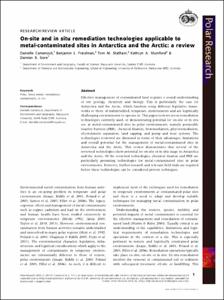On-site and in situ remediation technologies applicable to metal-contaminated sites in Antarctica and the Arctic: a review.

View/
Average rating
votes
Date
2014Author
Camenzuli, Danielle
Freidman, Benjamin L.
Statham, Tom M.
Mumford, Kathryn A.
Gore, Damian B.
Metadata
Show full item recordAbstract
Effective management of contaminated land requires a sound understanding of site geology, chemistry and biology. This is particularly the case for Antarctica and the Arctic, which function using different legislative frameworks to those of industrialized, temperate environments and are logistically challenging environments to operate in. This paper reviews seven remediation technologies currently used, or demonstrating potential for on-site or in situ use at metal-contaminated sites in polar environments, namely permeable reactive barriers (PRB), chemical fixation, bioremediation, phytoremediation, electrokinetic separation, land capping, and pump and treat systems. The technologies reviewed are discussed in terms of their advantages, limitations and overall potential for the management of metal-contaminated sites in Antarctica and the Arctic. This review demonstrates that several of the reviewed technologies show potential for on-site or in situ usage in Antarctica and the Arctic. Of .....
Journal
Polar ResearchVolume
33Issue
21522Page Range
15pp.Document Language
enSustainable Development Goals (SDG)
14.1Spatial Coverage
Arctic RegionAntarctic Region
DOI Original
https://doi.org/10.3402/polar.v32.21522Citation
Camenzuli, D., Freidman, B. L., Statham, T. M., Mumford, K. A.and Gore, D. B. (2013) On-site and in situ remediation technologies applicable to metal-contaminated sites in Antarctica and the Arctic: A review. Polar Research, 32:21522, 15pp. DOI: https://doi.org/10.3402/polar.v32.21522Collections
- CAPARDUS Practices [147]
The following license files are associated with this item:
 Repository of community practices in Ocean Research, Applications and Data/Information Management
Repository of community practices in Ocean Research, Applications and Data/Information Management
